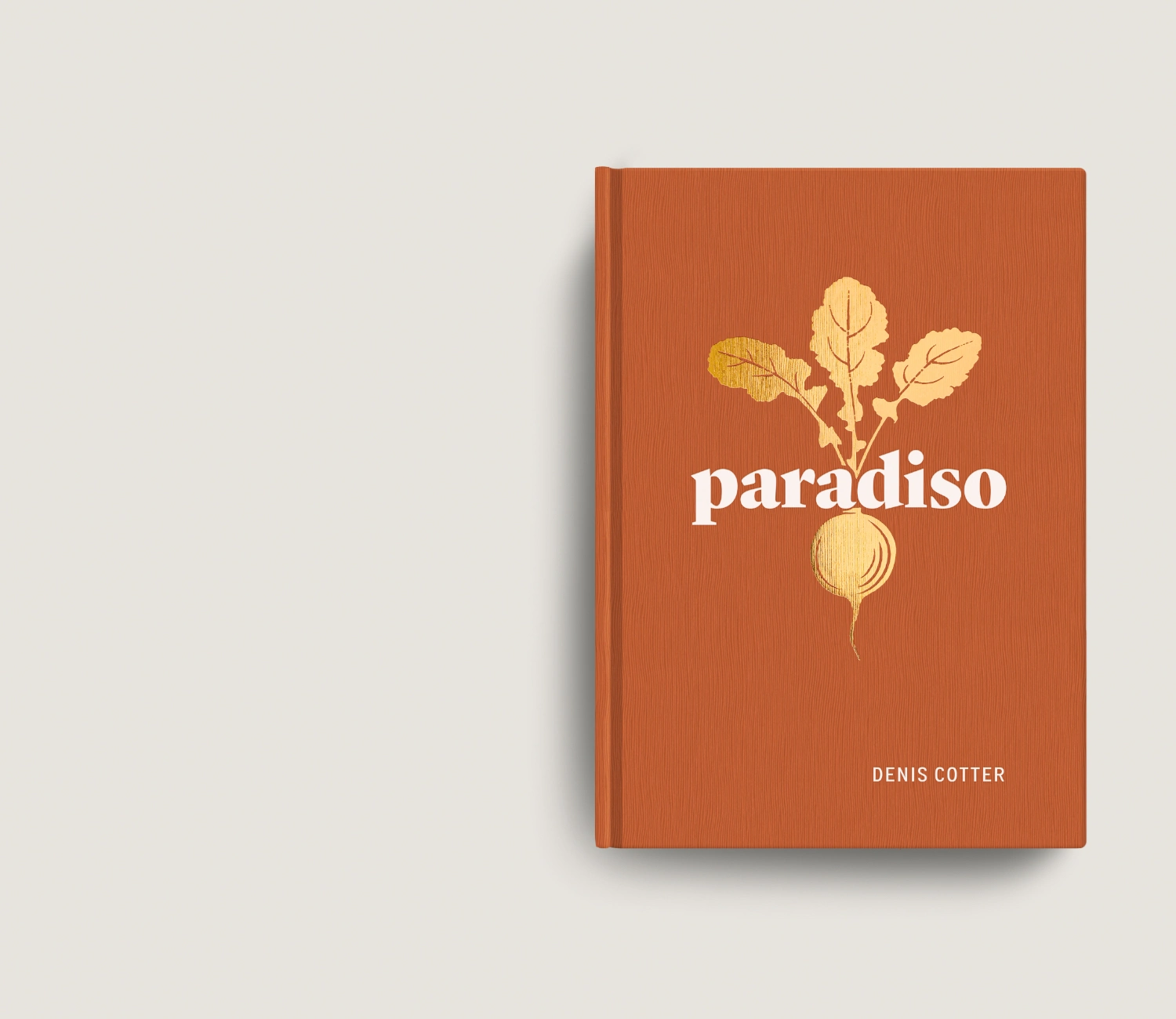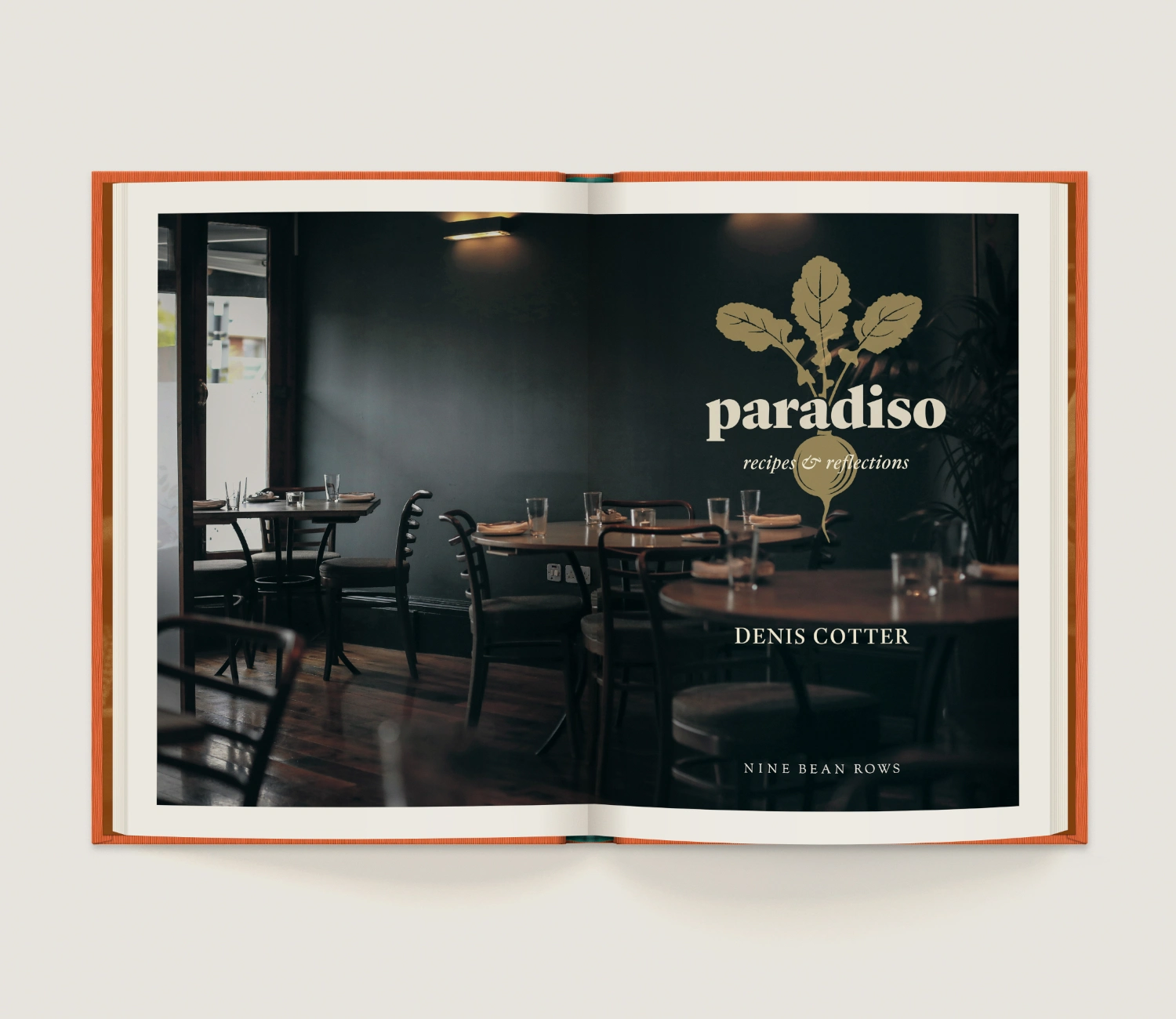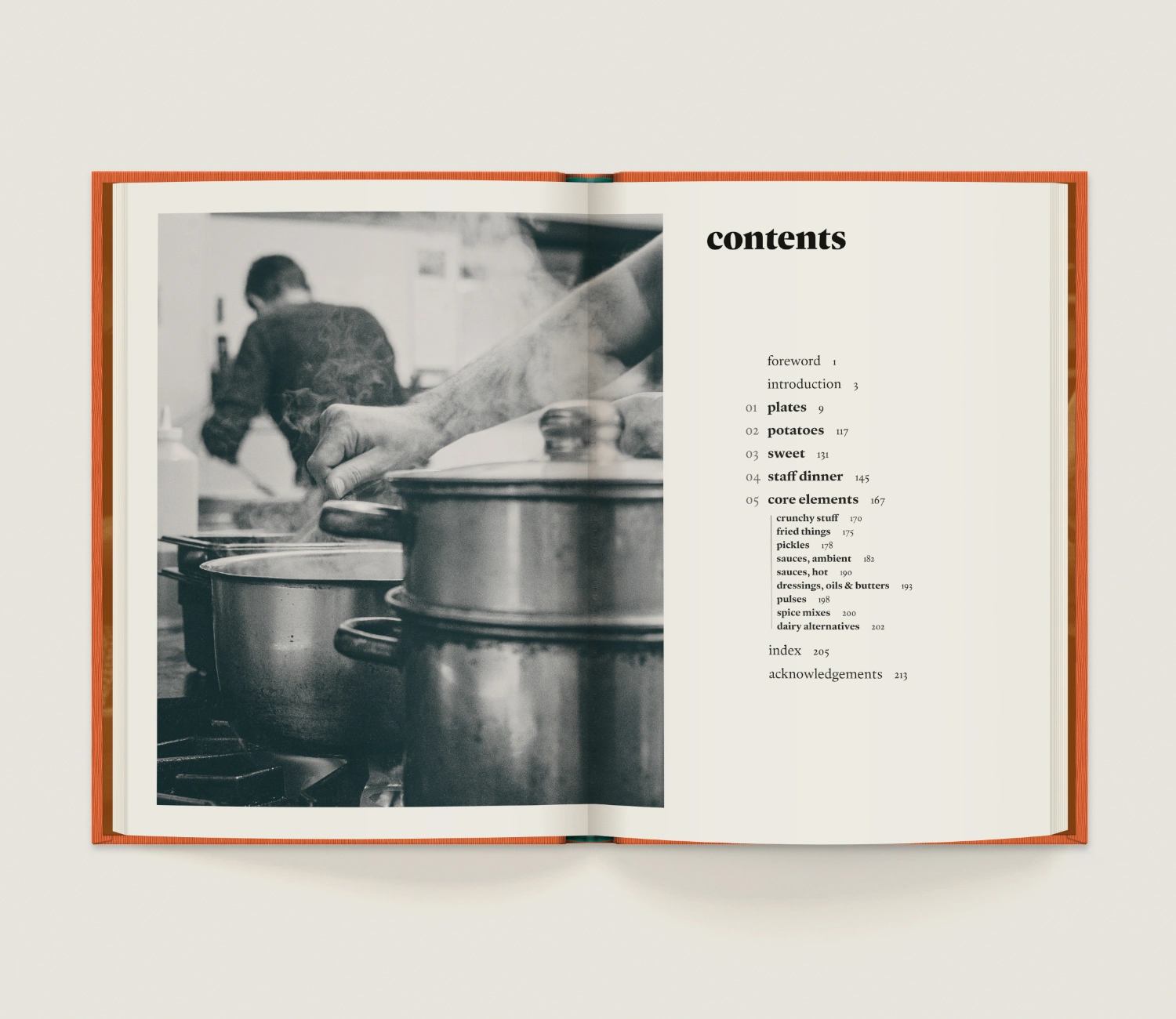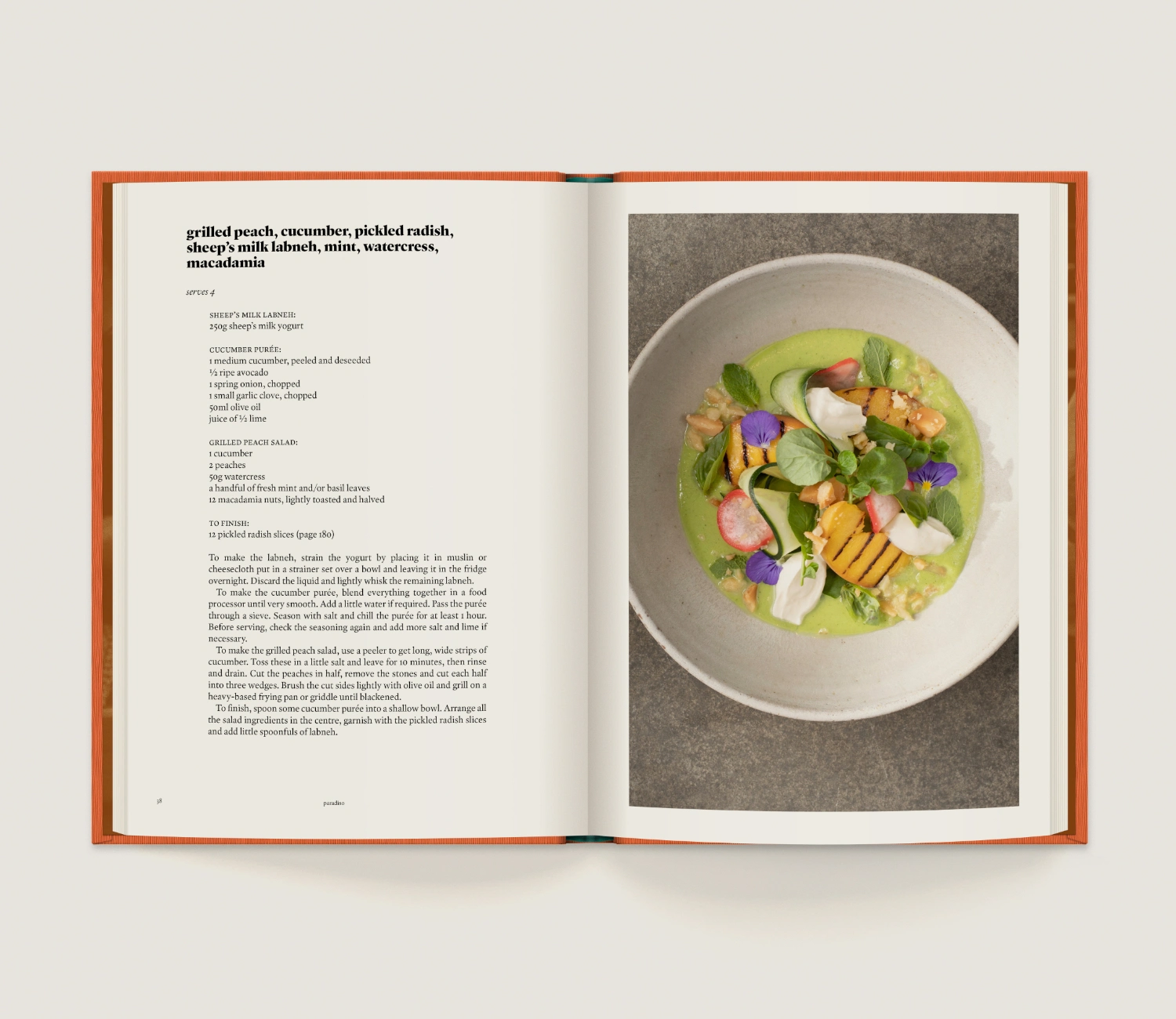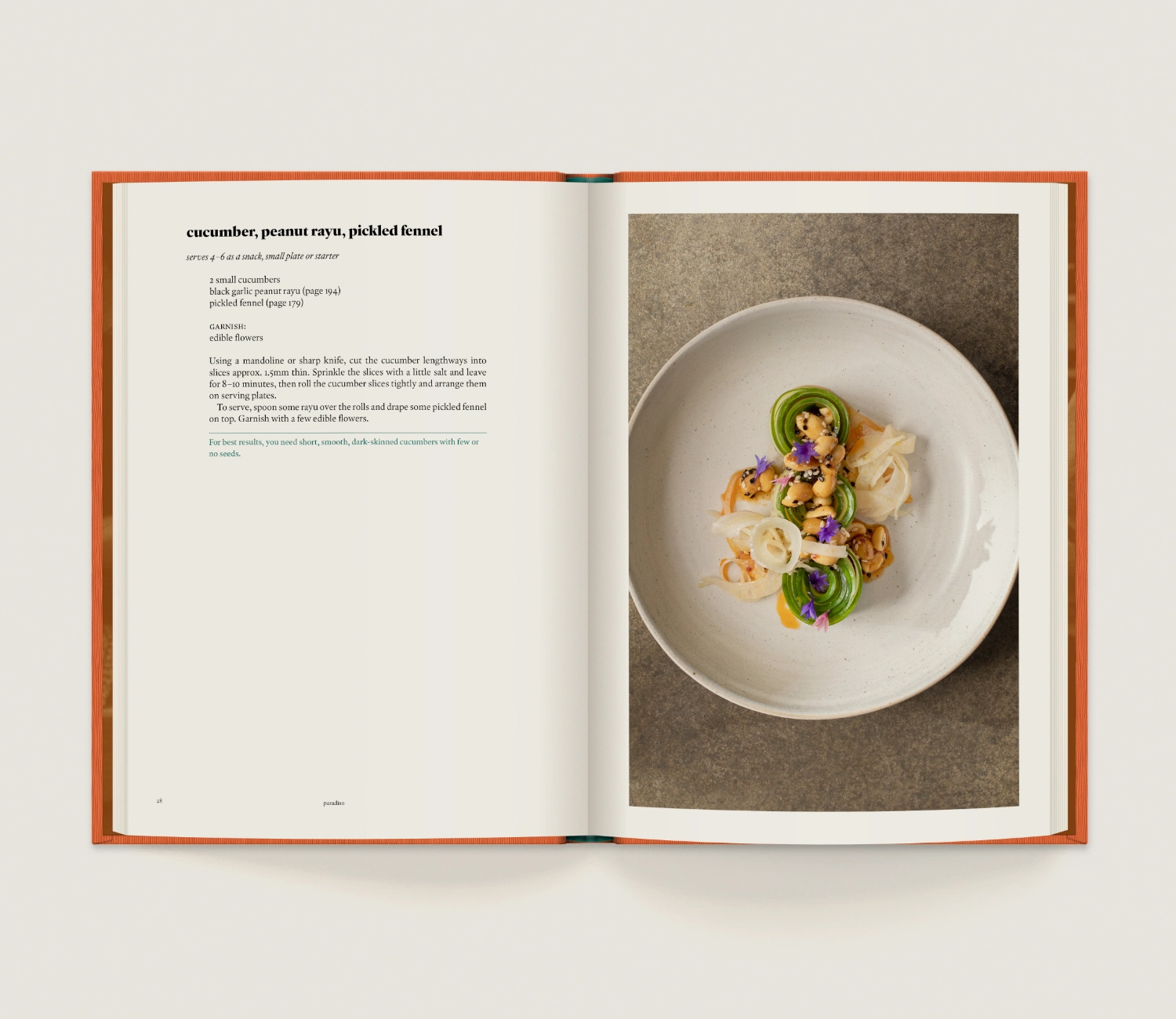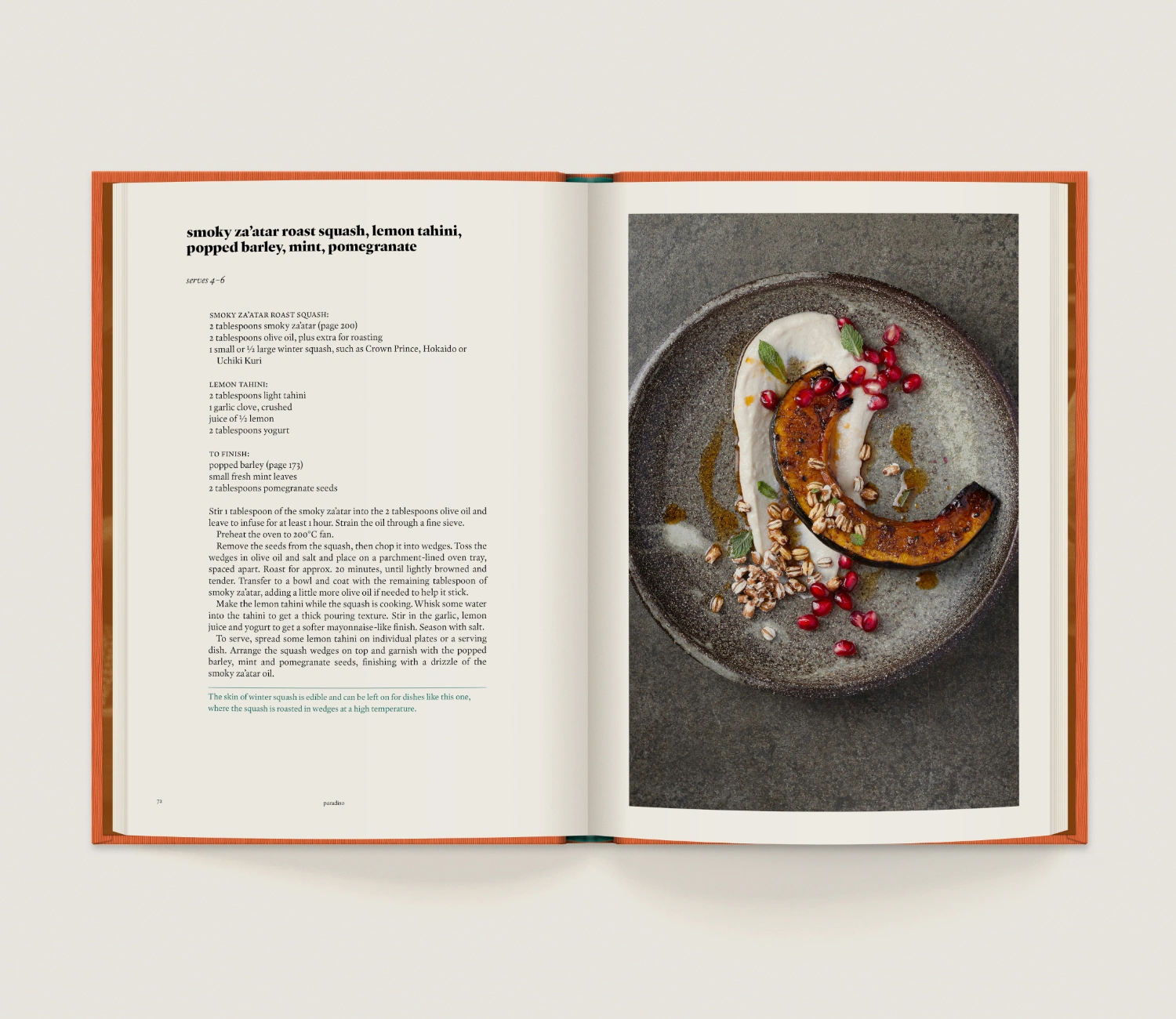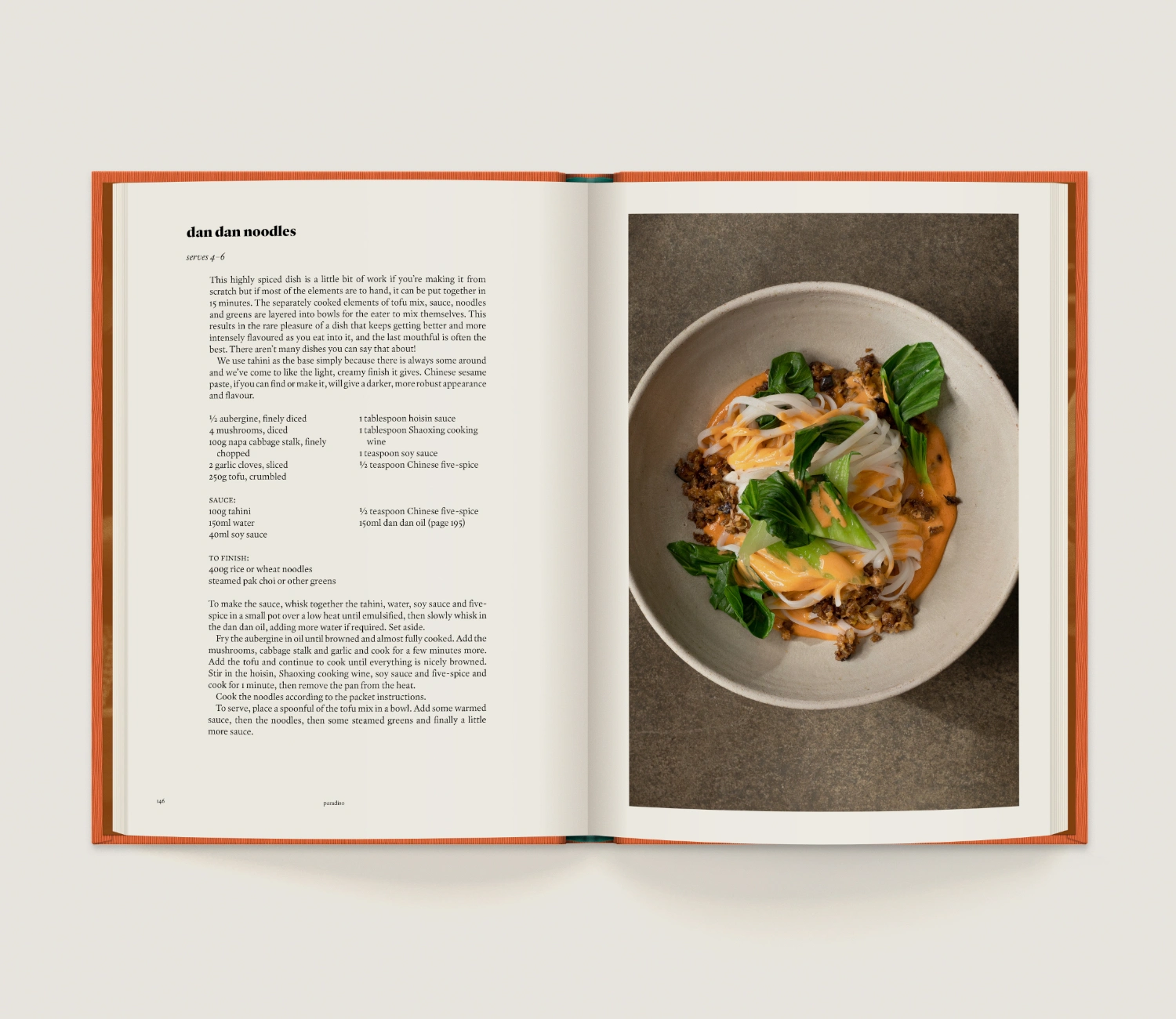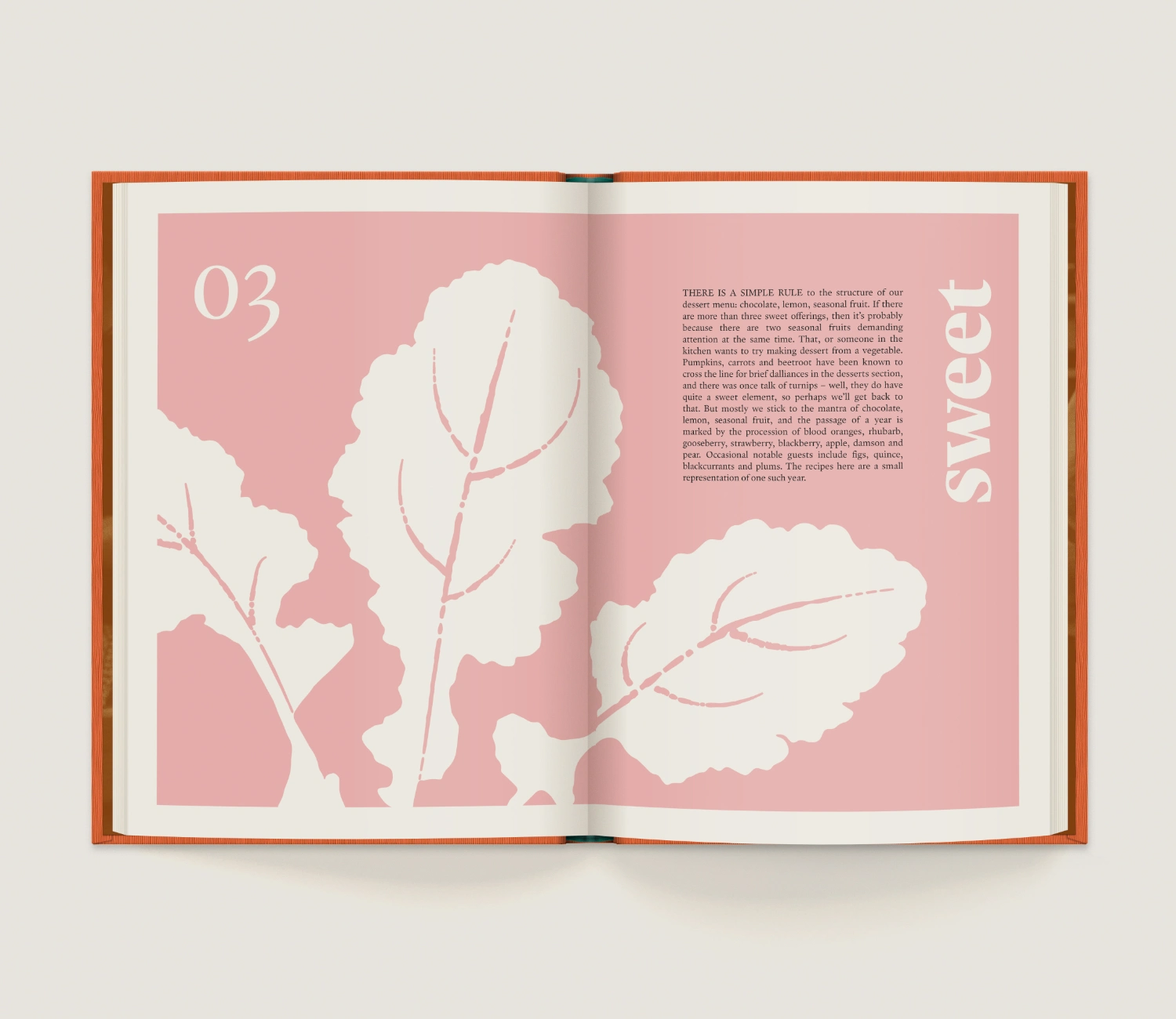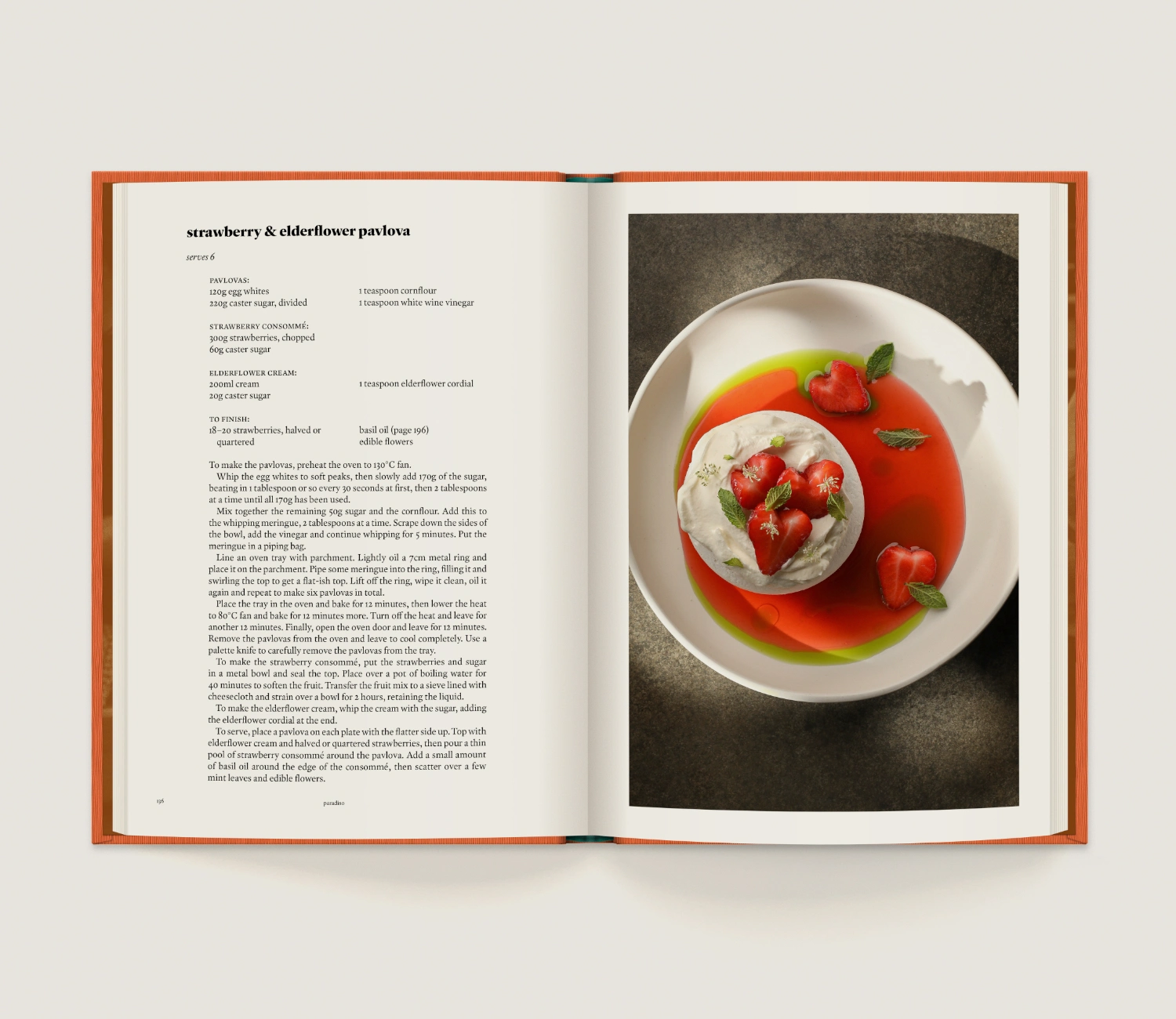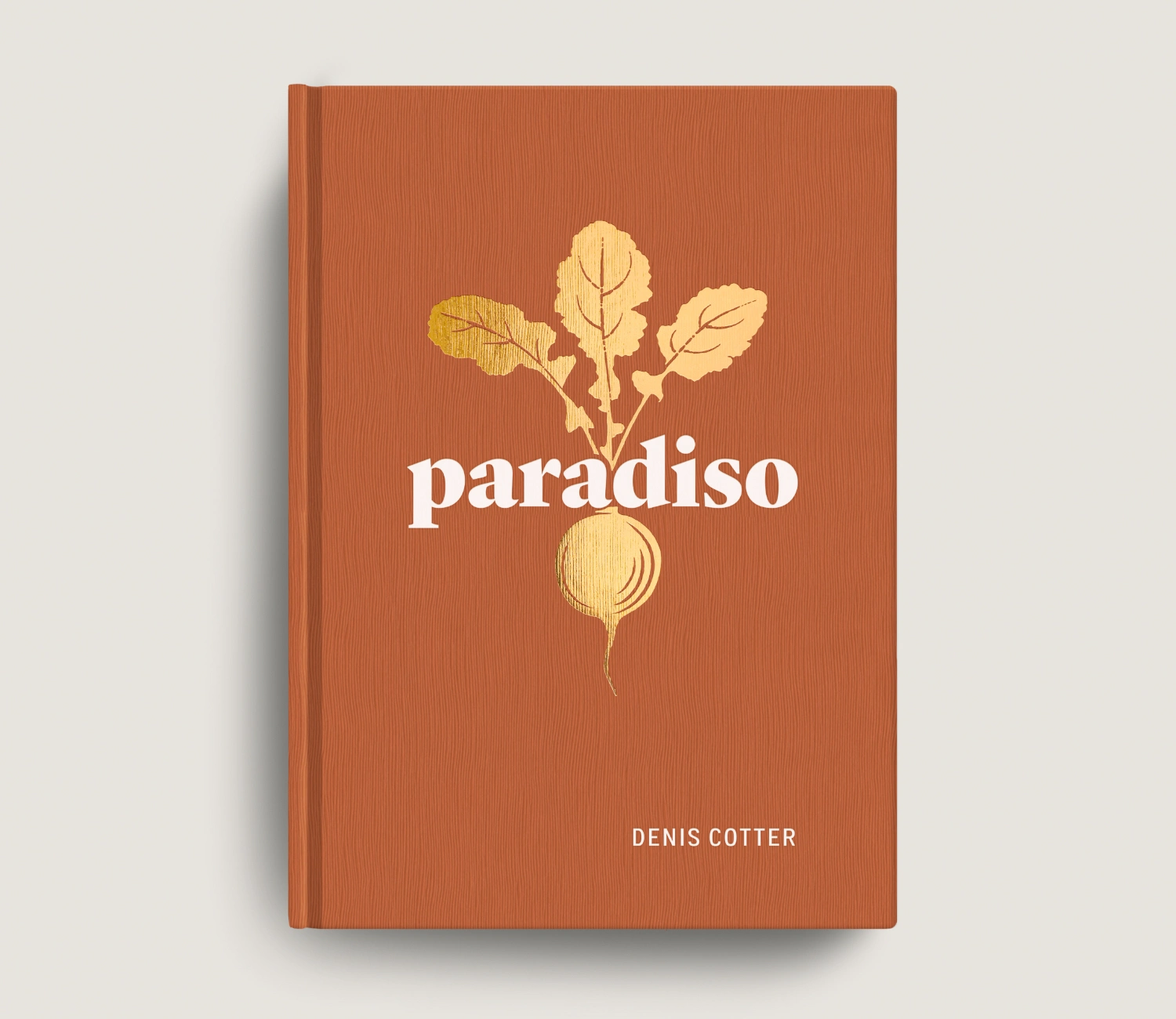paradiso
Recipes & Reflections
Published on 8th May 2023, Paradiso, recipes & reflections is a celebration of the unique cuisine of this internationally renowned Cork restaurant. Thirty years on from the restaurant’s beginnings, the new book reflects the evolved repertoire as it features on current seasonal menus. It shows how these complex and flavour-driven dishes are put together in the restaurant kitchen, and, in a special ‘core elements’ section, teaches how to make the building blocks that can bring a touch of Paradiso to everything you cook. Throughout the book there are essays by the author and founder-chef of Paradiso, Denis Cotter, illuminating the way in which the cuisine of Paradiso has become its own unique living thing.
The foreword to Paradiso, recipes & reflections is by Cork-born actor, Cillian Murphy, who has a long-standing affection for the restaurant.
With wonderful photography by Ruth Calder-Potts and timelessly beautiful design by John Foley of Bite Design, it’s no wonder that John and Sally McKenna of McKenna Guides have already called it ‘a landmark title in Irish food publishing’.
It was awarded 'Cookbook of the Year' at the Irish Food Writing Awards 2023.
Paradiso is in all good bookshops now and is also available to buy online and in the restaurant itself.
Sample recipes
A key section of the book, Paradiso, is the ‘core elements’ chapter, in which you will find short recipes for all of the building blocks that we use in the restaurant kitchen to deliver the essence of Paradiso to each dish. The sauces, dressings, pickles and crunchy things in this section are simple to make and will bring a touch of Paradiso to everything you cook at home. We will be posting some of our favourites here over the coming weeks and months, including suggestions for how they can be used beyond their role in the book dishes.
from paradiso - core elements · dressings, oils & butters (p. 194)
hazelnut rayu
This hazelnut twist is just one of a number of variations of the classic soy-sesame-garlic-oil dressing that we use to bring a depth of flavour to simply cooked greens. With comforting levels of heat from ginger and Korean pepper flakes, it is particularly good on sprout tops in the middle of winter, which we serve with scorzonera fritters, wasabi mayo and pickled plum. And the rayu has perhaps a more upfront role in the simple treatment of frivole, or flowering sprouts, on page 114 of 'paradiso'.
Here, the greens are braised in a little oil and then dressed with the rayu just before the pan is taken from the heat. Make sure to pour all of the pan juices over the greens on the plates or serving bowl.
This makes 250mls, approx 12-15 portions, and keeps well in the fridge.
125mls vegeetable oil
3 garlic cloves, finely minced
25g fresh ginger, peeled and finely minced
1 spring onion, finely chopped
75g hazelnuts, toasted and coarsely chopped
15g sesame seeds, lightly toasted
40mls sesame oil
1 tablespoon soy sauce
1 tablespoon Korean hot pepper flakes
Warm the vegetable oil in a saucepan over low heat. Add the garlic, ginger and spring onion and cook for a few minutes until the garli just starts to colour. Add the rest of the ingredients and take the pan off the heat. Season with a little salt. Leave to cool, then store in an airtight container.
from paradiso - core elements · crunchy stuff (p. 171) and · sauces, ambient (p. 187)
smoked tomato
Smoked tomato brings a touch of smokiness to a dish, delivered in the rich, complex flavours of slow-dried tomatoes.
Sometimes we do this with a simple blob of puree, as in the dish of napa cabbage, lentils, fennel, capers & smoked tomato. Other times, we use the smoked tomato crumb, and occasionally - as in the beluga bowl in the staff dinners chapter of the book - we use both for the combination of smokiness and texture.
This is all made simple and quick by using smoked sundried tomatoes that we get from West Cork Olives. If you can only get plain old sundried tomatoes, pop them in the smoker for a short while. You do have a smoker, don't you?
smoked tomato crumb
makes 1 small jar:
- 20g smoked sun-dried tomatoes
- 2 tablespoons extra virgin olive oil
- 100g breadcrumbs, from day-old bread
Use a food processor to make a paste with the smoked tomatoes.
Heat the oil in a heavy-based pan over medium heat. Add the breadcrumbs and toast until golden brown, tossing and stirring frequently. When crisp, remove the fried crumbs to a parchment-lined tray and leave to cool.
Preheat an oven to 60c or turn on a dehydrator.
Transfer the dried crumb to a bowl and stir in the smoked tomato paste, using your hands to fully combine the two. Season with salt.
Place this mixture back onto the parchment-lined tray and place in the oven or dehydrator to become crisp and dry. This will take 1-2 hours.
Leave to cool completely before storing in an airtight jar or container.
smoked tomato puree
- 200g smoked sun-dried tomatoes
- 200mls boiling water
- 50mls olive oil
Put the smoked tomatoes in a bowl and pour over the boiling water. Leave for 30 minutes to soften the tomatoes. Add the olive oil and blend to a smooth puree. Season with salt
from paradiso - core elements · dressings, oils & butters (p. 193)
psb dressing
'Dressings, oils & butters' is a small chapter in the Core Elements section of the book, but it contains some recipes that are vital to how we flavour certains of a dish, sometimes on the plate, sometimes in warm bowl before plating up and occasionally in the pan just before the end of cooking.
This dressing is one of the latter. It's called 'psb' because it was first used with purple sprouting broccoli, and chefs like to keep things short (and not have their spelling checked!). Then, when the purple sprouting broccoli went out of season, we found ourselves using it on cabbage, cavolo nero, spring greens, napa, green beans...in fact, anything green that is finished in a pan had a splash of psb dressing added for a few seconds just before the pan is taken from the heat. How much of a splash depends on how much of the psb flavours you want absorbed into the greens.
Same goes for how long that final cooking is - do you want the dressing to reduce and stick to the vegetable or do you want it to just lightly touch the greens and remain behind in the pan. Sometimes when you do the latter you might still pour the pan juices over the greens on the plate.
That's the thing really - how the psb dressing is used is quite intuitive and personal. Make a jar for yourself and see what it can do for your greens.
psb dressing
- 1 small garlic clove, grated
- 45ml tamari or soy sauce
- 1 tablespoon grated fresh ginger
- 2 teaspoons toasted sesame oil
- 2 teaspoons mirin
Whisk everything together. Store in a jar and shake well before use.
from paradiso - core elements · crunchy stuff (p. 171)
ras-el-hanout crumb
The 'crunchy stuff' section of the 'core elements' chapter of the book is an ever-growing treasure trove of crunchy things that deliver a final kick of flavour to a dish. Being the last thing to hit the plate, the crunchy element can accentuate flavours already present in a dish or it can take it off somewhere else entirely. This ras el hanout crumb is used in the book to firmly locate a roast carrot & mozzarella dish in North Africa, something that is hinted at in the burnt aubergine puree underneath the vegetables, whereas a differently flavoured crumb might just as successfully have taken us to southern Italy or deepest Mid-Cork (home of the Macroom buffalo mozzarella).
Ras el hanout is usually translated along the lines of 'from the top shelf', suggesting the best blend of spice in the shop or the home. So you will find many different styles and most are great. The recipe for crumb below assumes you have your favourite to hand, whether you make your own or buy it in. If you want to make one close to the paradiso version, the recipe for that is also below.
50g panko bread crumbs
1 teaspoon ras el hanout spice (see below)
Heat a little olive oil in a heavy pan and fry the breadcrumbs for 5-7 minutes over medium heat until golden.
Add the spice and a pinch of salt and continue cooking for a minute more.
Remove from the heat and leave to cool, before storing in an airtight container.
ras el hanout spice mix
You can buy good quality ras el hanout spice mix but, if you feel like making your own, this blend will give you the closest result to what we use in Paradiso.
2 teaspoons ground ginger
2 teaspoons ground mace
2 teaspoon ground nutmeg
2 teaspoon ground cinnamon
2 teaspoon ground allspice
2 teaspoon turmeric
20 black peppercorns, ground
8 cloves, ground
2 tablespoons cumin seeds, ground
1 tablespoon ground coriander seeds, ground
20 cardamom pods, ground
8 dry rose bud petals, ground
Grind the peppercorns, cloves, cumin, coriander and cardamom finely. Separately, grind the rose bud petals coarsely. Combine all the ingredients and store in a dry airtight container.
From paradiso – core elements · ambient sauces (p. 188)
sungold salsa
This very simple salsa makes the best of the sungold tomato's sweet and tart flavour. In the book, it is featured bringing zingy freshness to a summer lasagne, while at home it is used on everything from morning eggs to late night cheese on toast. It's great on savoury crepes, aubergine rolls and chard leaf parcels and anything that can handle a little extra summer sunshine.
- 200g sungold tomatoes, halved
- 2 fresh red chillies, deseeded and sliced
- 2 tablespoons olive oil
- 1 tablespoon sherry vinegar
Put the halved sungolds in a small pan with the chillies and olive oil.
Let the tomatoes simmer slowly over low heat for 2-3 minutes, until they are just beginning to soften. Off the heat, add the sherry vinegar and a little salt.
Serve warm or at room temperature.
From paradiso – core elements · pickles (p. 179)
pickled orange
This puree of pickled oranges is one of the most versatile core elements in the Paradiso kitchen, bringing a citrusy acidity to a wide range of dishes. In the book, it is featured on the summery Macroom buffalo mozzarella, fennel & strawberry, and it is the base of a sauce for a beetroot risotto with broad beans and hazelnuts. It keeps for months in a sealed jar.
- 8 oranges, washed, deseeded and sliced into 5mm-thick rounds
- 700g caster sugar
- 600ml white wine vinegar
- 1 fresh hot red chilli, chopped
- 1 cinnamon stick
- 1 tablespoon fennel seeds
Simmer the orange slices in boiling water for 30 minutes. Strain, discard the water and put the orange slices back in the pot with the rest of the ingredients. Simmer for 30 minutes more.
Leave to cool, then store in airtight containers for at least two days but preferably for two weeks before using.
Put the orange slices in a food processor and blend to a purée, adding a little of the pickling liquid to get a thick pouring consistency.
From paradiso – core elements · dressings, oils & butters (p. 195)
dan dan oil
This is a very hot oil with layers of fragrance from the star anise and cinnamon. In the book, it is used in the grilled dan dan cauliflower dish and to make classic dan dan noodles for staff dinner. Like most of the recipes in the Core Elements section of the book, once you have made a batch at home you will find loads of uses for it, from drizzling over soups and stews to whisking into dips and sauces.
Makes 1 litre. Keeps well for three months in a cool, dark place.
- 60g Sichuan peppercorns, coarsely chopped
- 20g dried bird’s eye chillies, coarsely chopped
- 20g Korean red pepper flakes
- 6 star anise
- 2 cinnamon sticks, broken
- 1 litre sunflower oil
Place the peppercorns and chillies in a saucepan with the Korean chilli flakes, star anise, broken cinnamon sticks and the oil. Heat gently on a very low heat until the oil is just beginning to simmer. Turn off the heat, cover the pan with a lid and leave to stand for at least 1 hour, but preferably for up to 24 hours.
Pass through a fine mesh sieve and, if necessary, a piece of kitchen paper, to get a clear oil. Discard the solids and store the oil.
Keep updated
To receive updates, subscribe to the restaurant mailing list and follow the restaurant on Instagram, Twitter or Facebook
